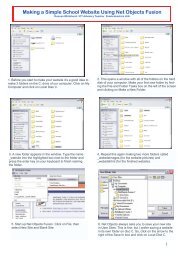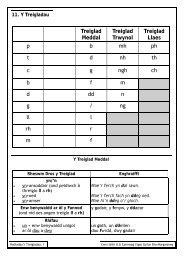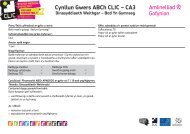Polyhedra – Mathematical process It is important that the children ...
Polyhedra – Mathematical process It is important that the children ...
Polyhedra – Mathematical process It is important that the children ...
Create successful ePaper yourself
Turn your PDF publications into a flip-book with our unique Google optimized e-Paper software.
• Tabulate results<br />
Shape Number of<br />
faces<br />
Cube<br />
Cuboid<br />
Number of<br />
vertices<br />
Number of<br />
edges<br />
6 8 12<br />
6 8 12<br />
Triangular<br />
pr<strong>is</strong>m 5 6 9<br />
Hexagonal<br />
pr<strong>is</strong>m 8 12 18<br />
Square based<br />
pyramid 4 4 6<br />
Hexagonal<br />
based pyramid 7 7 12<br />
Tetrahedron<br />
Octahedron<br />
4 4 6<br />
8 6 12<br />
Dodecahedron 12 20 30<br />
Icosahedron<br />
• Look for a pattern in results<br />
20 12 30<br />
If <strong>the</strong> results have been tabulated in th<strong>is</strong> way <strong>the</strong>n <strong>the</strong> relationship between <strong>the</strong><br />
faces, vertices and edges should be fairly easy for <strong>the</strong> <strong>children</strong> to identify. (The<br />
less able worksheet <strong>is</strong> worded in a way <strong>that</strong> leads <strong>the</strong>m towards finding <strong>the</strong><br />
relationship)<br />
Cube<br />
Cuboid<br />
Triangular pr<strong>is</strong>m<br />
Hexagonal pr<strong>is</strong>m<br />
6 + 8 2 = 12<br />
6 8 12<br />
5 + 6 2 = 9<br />
8 12 18<br />
The pupils should<br />
notice <strong>that</strong> <strong>the</strong> number<br />
of edges can be found<br />
by adding toge<strong>the</strong>r <strong>the</strong><br />
faces and vertices and<br />
<strong>the</strong>n subtracting 2.








